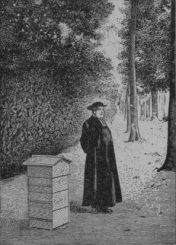
Warré plans
Warré methods
Warré modifications
Warré precursors
Groups / Fora
Google
e-group
Biobees.com
forum
Abbé Warré's book
Beekeeping for All:
Smoking the bees down
On page 111 of Beekeeping for All Warré describes how to clear bees from honey boxes to be harvested. His method is to smoke the bees down into the box below, using the top-bar cloth to keep the smoke in and speed up the process. Some have found that the bees are sometimes reluctant to leave the box. Prolonged smoking could risk tainting the honey. However, Warré's method is nevertheless worth considering, especially as it is relatively simple.
Instead of smoke, one a fume board could be used with one of the more acceptable cocktails of bee clearing volatile compounds. If anyone reading this uses them with Warré hives we would be interested to hear details and possibly add a section to this page.
Here we describe a few further options for clearing bees. Whichever of the following methods is used, be sure that the box being harvested is free of brood and the queen, in the unlikely event of her being in the top box, has been smoked down into the box below.
Clearer board (bee escape)
There are a number of clearer board designs available as described here. The snag with the Warré hive is that, as a queen excluder is normally not used, there may be drones in the upper boxes to be harvested and thus the risk that the passages in the clearer board's bee escape would become blocked. So if drones are present it is essential to use a clearer board with 9 mm (3/8") escape holes.
This means that a commonly used rapid bee escape, the 8-way escape may be unsuitable if drones are present, as the apertures on some are only 6-7 mm. (A supplier in the USA.)
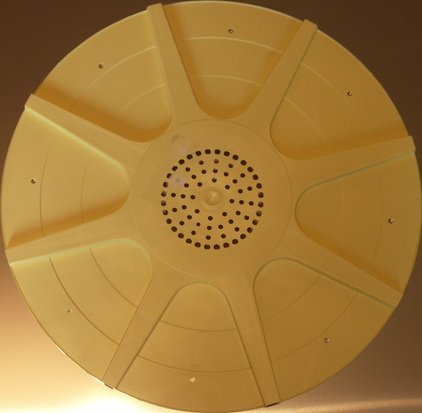 8-way bee escape
8-way bee escape
A Porter escape, a type popular in the UK which has springs forming a kind of non-return valve, is even less suitable if drones are present because they are likely to get stuck in the springs.
If an 8-way bee escape cannot be found, then one could be made from plywood, for example along the lines of David Heaf's home made clearer board. To allow easy transit for the bees from the combs to the top of the board its upper surface should be flat, i.e. have no rim round it. There is already a bee space below the combs in the box to be cleared, so further space is not required here. Below the clearer board, it is important to allow adequate space for the cleared bees to gather, at least initially. A rim of about 30 mm is suggested.
Andrew Janiak has pointed out that using this system with Warré boxes of honey might be messy due to breaking comb bridges between the box to be harvested and the top-bars of the box below. This can be dealt with by temporarily resting the box to be harvested on wedges of no more than 3 mm (1/8") a long enough period of time for the bees to clear up any exposed honey.
The above 8-way escape fitted to a clearer board can be obtained from Beeologique (Bill Wood, Oregon): https://sites.google.com/site/beeologique/purchase-honey
Below: Bill Wood's Warré clearer board with an 8-way escape
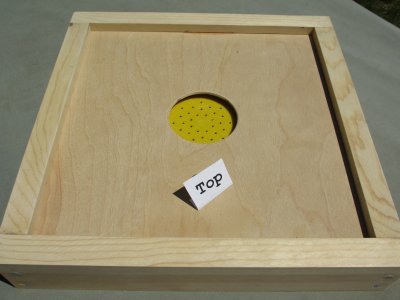
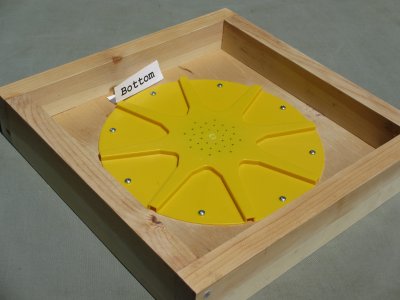
The following two photos show Bill Wood's clearer board with a lozenge escape, normally used on larger hives, adapted for the Warré hive by cutting slots in the side walls at opposite corners and covering the slots with plywood. Note the good depth under the board for bees to gather without creating congestion.
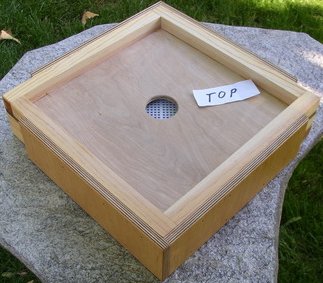
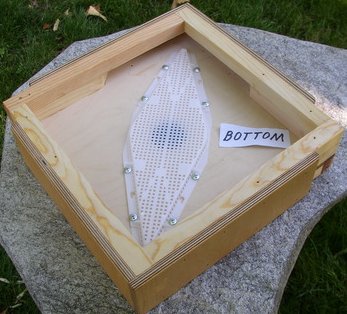
Removing the harvested box first, then clearing the bees
a) Clearing an unprotected box in the open
John Moerschbacher (Alberta) comments as follows: "Timing is everything when trying to harvest. I try to harvest while the honey flow is still going on. The bees are not usually super-protective then, and there is little danger of precipitating robbing. In any case, having a smoker handy can save you getting stings, and save the lives of a lot of bees.
I never try to remove individual combs with frameless hives. My preferred method of harvesting is to pump some smoke down into the box I want to take, remove the box, and place it on a stand in a shady spot not far from the bee yard. If there is no brood in the box (something you should ascertain before you remove it) then the bees will readily leave it and return to the hive before dusk. This has worked well for me for more than 30 years."
b) Clearing a closed box with a cone clearer board
If there is a risk of robbing by other bees in the apiary, i.e. there is no nectar flow, or there is a possibility of other animals helping themselves, then the following method may be preferable.
Andrew Janiak (Melbourne) uses the following method: The box to be harvested is removed, having checked it is free of brood, and placed close to the hive on a suitable bee-proof tray to collect any dripping honey. On top of the honey box is placed a board with a few bee escape cones made of fly screen mesh (see photos below).
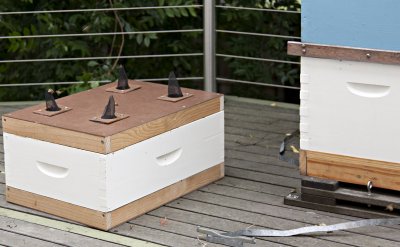
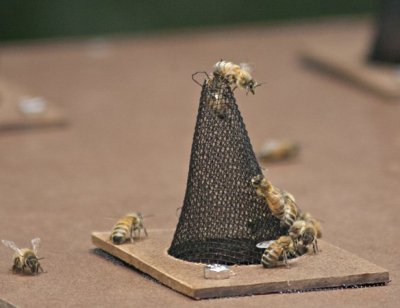
This is left in place for between two and four hours. Almost all the bees leave through the cones as they are drawn to the light. The hive bees show no interest in entering via the cones. There are usually a few bees left, such as young drones and house bees who are reluctant to leave. These are not aggressive. If ants or other animals are a problem, the honey box is placed well above ground. An advantage of this method is that its progress can easily be monitored. When workers/drones stop leaving the cones the clearing is as complete as it is likely to get.
If bees, instead of leaving the box, start clustering on the escapes, then it is clear that the queen is still in there. In which case it should be put back on the hive with care not to crush any bees and the process repeated. To increase the chances of the queen going down into the boxes not to be harvested, the bees may be lightly smoked down between the bars. The light entering at the top helps this process. If the hive is one with windows, they should all be shuttered except the one in the top box.
Here is a short video of this type of escape in action on a
rooftop in London:
https://www.youtube.com/watch?v=t_aSa2yhIOw
The holes in the top of the cones were formed round a pen (thanks to Bill Anderson for this video).